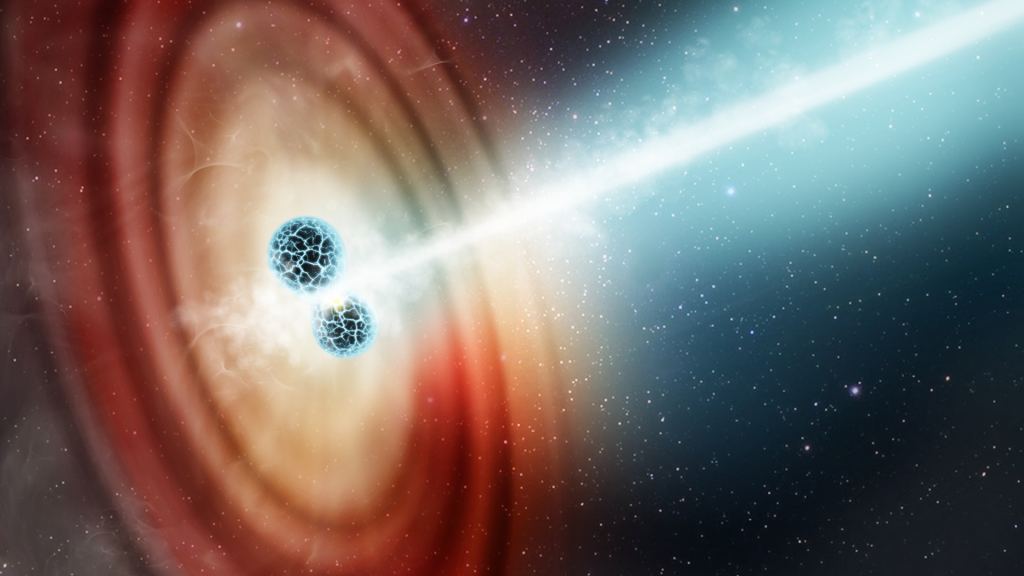In August 2017, astronomers observed a Gravitational Wave (GW) signal that resulted from the merger of two neutron stars – known as a “kilonova” event. The aftermath of this event (GW170817) was studied by 70 ground-based and space-based observatories in multiple wavelengths. This was the first time astronomers observed a binary neutron star merger in terms of electromagnetic radiation (particularly gamma rays) and GWs.
The energy released by this merger was comparable to that of a supernova, leading astronomers to theorize that it must have resulted in a black hole. Two years later, the Hubble Space Telescope observed the remnant and noted the powerful afterglow and gamma-ray bursts (GRBs) created by the merger, which was consistent with a black hole. However, it would take several more years of analysis before scientists could draw a complete picture of what resulted from this explosive event.
Using data from Hubble and several radio observatories, a team of researchers detected a rapidly-rotating disk of material around the black hole and a structured relativistic jet emanating from it. The team consisted of Kunal P. Mooley, Jay Anderson, and Wenbin Lu, specialists in the emerging field of Time Domain and Multi-Messenger Astrophysics (TD-MMA).
Mooley is an astrophysicist with the National Radio Astronomy Observatory (NRAO) and Caltech, while Anderson is an AURA Observatory Scientist with the Space Telescope Science Institute (STScI). Lu is an assistant professor at UC Berkeley and a Spitzer Fellow at Princeton University. The paper describing their findings was recently published in the October 13th edition of Nature.
The TD-MMA process involves using multiple “messengers” (like certain wavelengths of light and GWs) to study the Universe as it changes over time. To this end, Mooley, Anderson, and Lu relied on optical data from Hubble and radio observations from several National Science Foundation (NSF) telescopes taken 75 and 230 days after the explosion. Last, they consulted astrometry data from the ESA’s Gaia satellite, which produced highly-constrained estimates of the black hole’s position and proper motion.
This allowed them to combine very long baseline interferometry (VLBI) radio measurements with the afterglow’s light curve and measurements of its relative motion since it was first detected. The combined data allowed them to pinpoint the explosion site, and debris created from the explosion was drawn in by the black hole. This material was pulled into a rapidly-spinning disk that caused superluminous jets to emanate from its poles that crashed through and swept up material from the expanding debris cloud.
“I’m amazed that Hubble could give us such a precise measurement, which rivals the precision achieved by powerful radio VLBI telescopes spread across the globe,” said Mooley. Whereas the Hubble data indicated the hot jet had an apparent velocity of seven times the speed of light, the radio observations showed that the jet decelerated later to an apparent velocity of four times the speed of light. In keeping with “superluminous” motion, this was an illusion caused by the fact that as a jet approaches Earth at nearly the speed of light, light emitted later has a shorter distance to travel.
In brief, a relativistic jet chases its own light, and more time has passed between the jet’s emission of light than the observer perceives. This causes the object’s velocity to appear to be moving faster than the speed of light, which is physically impossible. Correcting for this, Mooley and his colleagues obtained accurate estimates of the jet’s velocity that showed it traveling at close to the speed of light.
“Our result indicates that the jet was moving at least at 99. 97% the speed of light when it was launched,” said Lu. Artist’s impression of a black hole surrounded by superheated material and a relativistic jet.
Credit: ESO/M. Kornmesser These findings greatly strengthen the long-presumed connection between neutron star mergers and short-duration GRBs, which require that a fast-moving jet emerge. They also pave the way for future precision studies of neutron star mergers and the superluminous jets that result.
These studies could help resolve one of the biggest mysteries in astrophysics today: the rate at which the Universe is expanding (aka. the Hubble Constant). Basically, there is a discrepancy between the estimated values obtained from measurements of the local Universe and those obtained from the early Universe.
The former value is based on extremely precise observations by Hubble and other observatories of Type Ia supernovae, which are a highly-accurate method for distance-keeping. The latter value is based on the Planck satellite‘s measurements of the Cosmic Microwave Background (CMB) – the relic radiation left behind by the Big Bang. With more relativistic jets available for study using a combination of gravitational waves, VLBI radio data, and theoretical modeling, astronomers could turn neutron star mergers into a new method for measuring cosmic expansion.
These methods will be especially useful for next-generation telescopes like the Nancy Grace Roman Space Telescope (RST), Hubble‘s most direct successor, which is slated to launch by 2026. Further Reading: NASA The post Hubble Examines the Wreckage From the 2017 Kilonova appeared first on Universe Today. .
From: universetoday
URL: https://www.universetoday.com/158119/hubble-examines-the-wreckage-from-the-2017-kilonova/



